Effective Ways to Eliminate Hard Water Stains
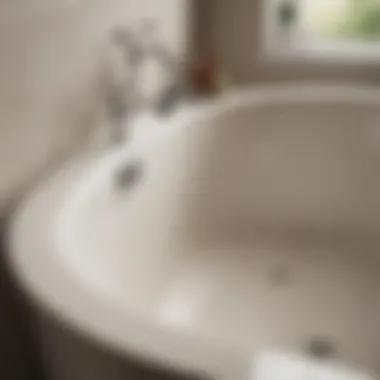
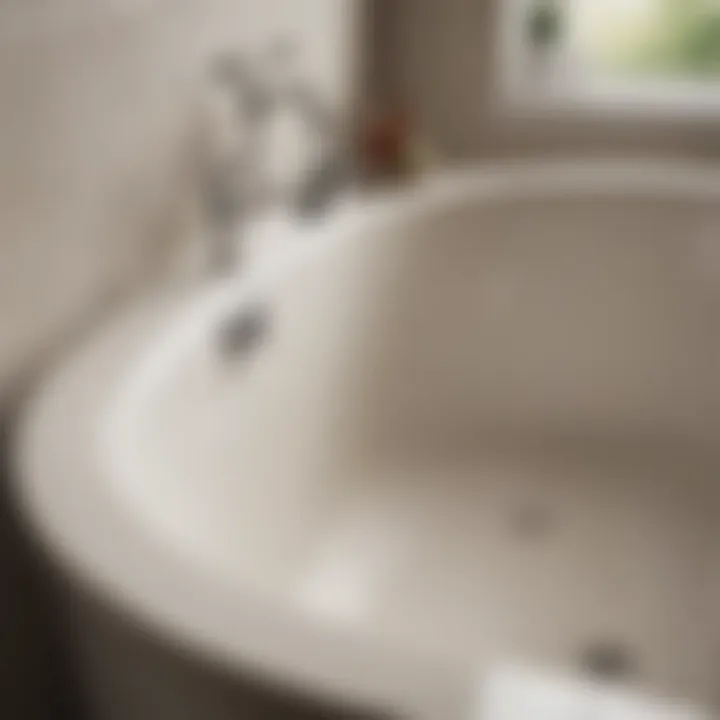
Intro
Hard water stains can be a real nuisance, especially in bathrooms where aesthetics matters. Homeowners often find themselves trying various methods to eliminate these unsightly marks from their bathtubs. These stains not only detract from the overall appearance but may also affect the longevity of the bathtub surface. Understanding how to remove hard water stains effectively is essential for maintaining both beauty and functionality.
This article will delve into the most efficient techniques for removing hard water stains. It will cover both household remedies and specialized cleaning products. Additionally, the discussion will extend to preventative measures to keep your tub looking its best over time.
By using this guide, you can find methods that align with your priorities. These include considerations of effectiveness, cost, and environmental impact. Whether you are a homeowner seeking practical solutions or an interior design enthusiast, this guide is meant for you.
Understanding Hard Water Stains
Understanding hard water stains is crucial for effective tub maintenance, as these stains can significantly detract from the visual appeal and cleanliness of your bathing area. Hard water contains high levels of minerals, such as calcium and magnesium. Over time, these minerals deposit and crystallize on surfaces, leading to unsightly stains. By comprehending what causes these stains, their common locations, and the problems they can create, homeowners can adopt more efficient cleaning methods.
What Causes Hard Water Stains
Hard water stains occur due to the evaporation of water that carries dissolved minerals. When water dries on surfaces, it leaves behind these mineral deposits. The more frequently this process happens, the more build-up occurs. Factors such as the local water supply and the frequency of tub usage can influence the severity of stains. If you reside in an area with particularly hard water, your tub may require more frequent cleaning compared to areas with softer water.
Common Locations of Stains in the Tub
Hard water stains often appear in specific locations within the tub. Key areas to note include:
- Around the faucet: Water frequently splashes here and can dry without proper drainage.
- Bottom of the tub: This area tends to collect water after use and is a common site for mineral deposits.
- Joints or seams: The places where tub materials meet can trap water, leading to greater staining.
By being aware of these locations, homeowners can target cleaning efforts more effectively.
Why Hard Water Stains Can Be Problematic
Hard water stains are not merely a cosmetic issue. They can cause several problems for tub owners. First, the build-up can create a rough surface that becomes harder to clean and maintain over time. This can lead to more significant cleaning tasks and even eventual repairs or replacements. Second, the stains may harbor bacteria if not cleaned properly, posing hygiene risks. Lastly, hard water can lead to discoloration or deterioration of tub materials, affecting their longevity. Therefore, it is essential to address and manage hard water stains to ensure a clean and safe bathing environment.
Essential Tools and Materials
In addressing the challenge of hard water stains in bathtubs, the proper tools and materials play an essential role. They not only facilitate effective cleaning but also ensure that the surfaces of your tub do not get damaged during the process. Utilizing the right equipment can significantly enhance the overall effectiveness of your cleaning efforts. As such, understanding which tools to gather is crucial. The following subsections will discuss cleaning tools, solutions, and protective gear that can streamline your task and deliver optimal results.
Cleaning Tools Required
Sponges
Sponges are among the most common tools used for cleaning tubs. Their porous nature allows them to absorb liquids effectively, making them a great choice for applying cleaning solutions. The softness of most sponges enables them to clean surfaces without causing scratches, which is a critical consideration for maintaining the tub's finish. A key characteristic of sponges is their versatility; they can be used for both wet and dry cleaning activities. However, it’s important to note that sponges can retain bacteria if not cleaned properly, leading to potential hygiene issues when reused.
Scrub Brushes
Scrub brushes offer a more aggressive approach to cleaning compared to sponges. They are particularly effective for tackling stubborn stains and grime, which is common with hard water build-up. The sturdy bristles provide the mechanical action needed to lift dirt without requiring excessive scrubbing force. A notable advantage is that scrub brushes come in varying stiffness levels, allowing users to select one appropriate for their tub material. However, improper use can leave scratches on delicate surfaces, so care is necessary.
Cloths
Cloths are indispensable in the cleaning arsenal, serving multiple purposes from applying solutions to drying the surface post-cleaning. Their absorbency makes them ideal for wiping away residues and achieving a streak-free finish. The key drawback of cloths is that they can wear out quickly, especially with frequent washing. While cotton cloths are popular, microfiber cloths are preferable due to their durability and effectiveness in trapping dirt and moisture.
Cleaning Solutions Overview
Household Products
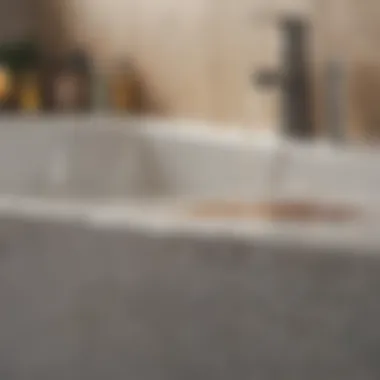

Household products provide an accessible and often economical solution for combating hard water stains. Common items like vinegar and baking soda possess natural cleaning properties that can dissolve mineral deposits. The most appealing aspect of these products is their non-toxic nature, making them safe for homes with children and pets. Their effectiveness can vary—stronger stains might not respond as well, requiring additional scrubbing or repeated application.
Specialty Cleaners
Specialty cleaners are formulated specifically for hard water stains, providing a robust solution. Products containing citric acid or sulfamic acid are particularly effective in breaking down mineral deposits. These cleaners save time and effort, often achieving results where household items might fall short. However, one must consider their chemical composition, as some may not be suitable for all tub materials, potentially causing damage or discoloration.
Protective Gear for Cleaning
Gloves
Using gloves while cleaning is crucial for both comfort and safety. The harsh chemicals in certain cleaning solutions can irritate the skin, making gloves a practical defense. A key feature of cleaning gloves is their ability to provide a barrier while enhancing grip on tools. Opting for latex, nitrile, or rubber gloves ensures protection, but it is important to select a size that allows flexibility and comfort.
Protective Eyewear
Protective eyewear is another essential consideration when cleaning with harsh substances. Small splashes of chemicals can lead to serious eye irritation or damage. The primary advantage of eyewear is the prevention of unwanted exposure, allowing users to focus on the task without worry. Selecting high-quality eyewear that fits securely is crucial to ensure maximum protection during the cleaning process.
Homemade Solutions for Stain Removal
Homemade solutions for removing hard water stains present an effective and economical alternative to commercial products. There are several reasons why one should consider these methods. First, they utilize common household ingredients, making them easily accessible. This can save time and money, especially for homeowners looking for immediate solutions without extra expenditures. Second, they are often much less harsh on bathroom surfaces compared to commercial cleaners. Many commercial products can contain harsh chemicals, which may risk damaging the tub material over time. Lastly, homemade solutions often demonstrate comparable or superior effectiveness in dealing with hard water stains, while being more environmentally friendly.
Vinegar and Baking Soda Method
The vinegar and baking soda method is widely regarded as one of the most effective DIY formulas for tackling hard water stains. To begin, gather white vinegar and baking soda. The process involves several simple steps:
- Application of Vinegar: Pour white vinegar directly onto the stained areas of the tub. The acidity of the vinegar works to break down the mineral deposits found in hard water stains. Let it sit for about 15-30 minutes to ensure proper penetration.
- Adding Baking Soda: After the vinegar has set, sprinkle a generous amount of baking soda over the same areas.
- Creating a Paste: The reaction between the vinegar and baking soda will create a fizzy solution that helps lift the stains. You can use a sponge or a cloth to scrub gently in circular motions, focusing on heavily stained areas.
- Rinse: After scrubbing, rinse the tub thoroughly with warm water, ensuring that all residues are removed.
This method not only removes stains but also deodorizes the bathroom, contributing to an overall fresh environment.
Lemon Juice Application
Using lemon juice for stain removal is another excellent homemade option. The natural acidity of lemon helps to dissolve mineral deposits effectively. Here is a straightforward approach:
- Squeeze Fresh Lemon: Take a fresh lemon and cut it in half. Squeeze the juice onto the stained areas or simply rub a half lemon directly onto the stains.
- Let it Sit: Allow the lemon juice to sit for about 15-20 minutes.
- Scrubbing: After letting it work, scrub the area with a soft cloth or sponge. The citric acid will have worked to break down the deposits, making them easier to remove.
- Final Rinse: Rinse thoroughly with warm water and wipe dry.
Lemon juice also leaves a pleasant scent, enhancing the cleaning experience.
Dish Soap and Water Mixture
A simple mixture of dish soap and water is effective against lighter stains and provides a gentle cleaning action:
- Prepare the Mixture: Combine a few drops of dish soap with warm water in a bucket or spray bottle. Mix thoroughly to create a soapy liquid.
- Application: Apply the mixture to the stained areas, using either a sponge or cloth to distribute evenly.
- Scrubbing: Allow it to sit for a few minutes. Following this, scrub with a sponge or scrub brush for more stubborn stains.
- Rinse Off: Finally, rinse the tub with warm water, ensuring that no soap residue remains.
This method is not only efficient but also safe for regular maintenance, preventing the buildup of hard water stains before they become more challenging to remove.
Commercial Products for Stain Removal
Using commercial products for removing hard water stains is a popular choice among homeowners and anyone looking to maintain a clean bathroom environment. These products are designed specifically to combat the mineral deposits left behind by hard water, which can be tough to eliminate with standard cleaning solutions. Their efficacy often leads to quicker results, saving time and effort.
Many people face challenges with surface stains that persist despite regular cleaning. Commercial cleaners often contain powerful ingredients that can dissolve tough stains and restore surfaces to their original shine. However, it is important to evaluate the specific needs of your tub and to consider various factors before making a choice.
Overview of Effective Products
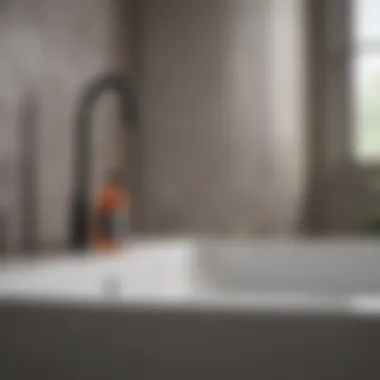
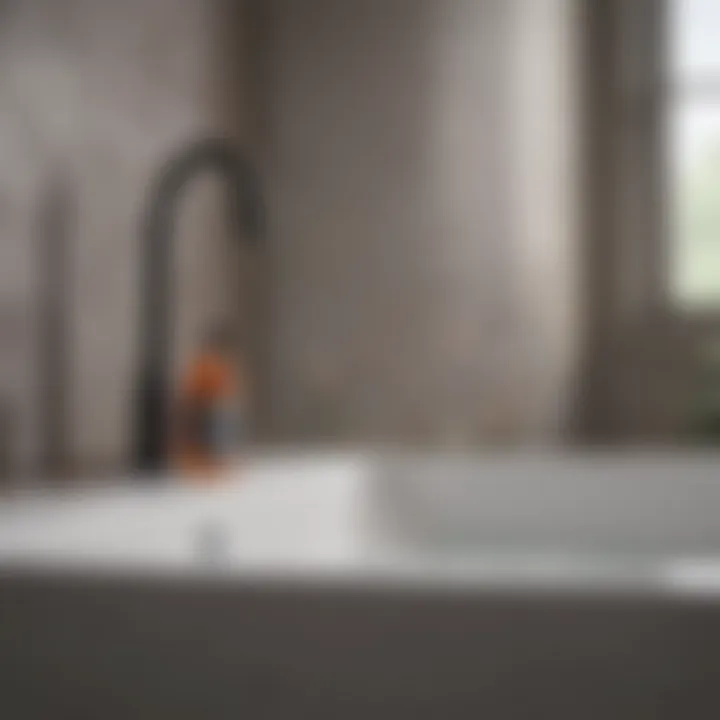
There are several commercial products on the market that target hard water stains effectively. Some of the most recognized brands include
- CLR (Calcium, Lime, and Rust Remover): This product is popular for tackling mineral deposits in various surfaces, including bathtubs.
- Kaboom Foam-Tastic: This cleaner works well due to its foaming action, which clings to stains and breaks them down.
- Zep Calcium, Lime and Rust Stain Remover: Known for its powerful formula, this product is used to eliminate tough stains.
- Scrubbing Bubbles: While less strong than others, it can be an effective solution for routine cleaning and stain prevention.
It’s crucial to follow the manufacturer’s instructions when using these products, to ensure safety and best performance.
Environmental Considerations in Product Choice
When choosing commercial products, environmental impact should not be overlooked. Many cleaners contain chemicals that can harm aquatic life and pollute water supplies if not disposed of properly. Look for products labeled as biodegradable or environmentally friendly. This not only benefits the environment but also contributes to safer home health, reducing exposure to harsh chemicals. Additionally, consider brands that conduct sustainable practices in their production and packaging. Opting for eco-conscious products can significantly lessen one's carbon footprint.
Cost-Effectiveness of Various Products
Cost is an important consideration when selecting cleaning products. Many commercial stain removers vary widely in price, and this can influence homeowner choices.
- Budget Options: Many effective products are available at a lower price point. However, they may require more application to achieve the desired results.
- Premium Products: Higher-priced options often feature stronger formulas that can eliminate stains on the first application. This can result in savings in the long run when considering both time and additional product used.
- Concentrates vs. Ready-to-Use: Concentrated formulas offer more value as they can be diluted, allowing for multiple uses from a single bottle.
Weighing these factors is essential to determine the best value for your specific needs and circumstances, making informed choices that align with your cleaning goals.
Step-by-Step Cleaning Process
A structured cleaning process is essential for effectively removing hard water stains from your tub. This section outlines the steps involved, providing clarity and ensuring that each detail is attended to for optimal results. Following a systematic approach minimizes the risk of damage to your tub and enhances the efficiency of your cleaning efforts.
Preparing the Tub for Cleaning
Before diving into any cleaning task, preparation is vital. Start by removing any items from the tub, such as toiletries, bath mats, or decorative elements. This allows for unobstructed access to the surfaces that require cleaning.
Next, give the tub a preliminary rinse to remove loose debris and dirt. It is advisable to use warm water for the rinse, as it helps to loosen any stubborn particles. After rinsing, inspect the surfaces for particularly tough stains. Making a note of these areas will guide the application of your cleaning solution later on.
Application of Cleaning Solution
Once the tub is prepped, applying the chosen cleaning solution is the next step. Depending on the severity of the hard water stains, you may opt for a homemade solution, such as the vinegar and baking soda mixture, or a store-bought cleaner specifically designed for hard water removal.
To apply, you can use a spray bottle for even distribution or pour the solution directly onto affected areas. Make sure to cover them sufficiently, ensuring that the solution saturates the stains. Allow the solution to sit for a specific period as per the product instructions, typically around 10 to 30 minutes. This dwell time is crucial, as it allows the active ingredients to break down mineral deposits effectively.
Scrubbing Techniques for Effective Cleaning
After the solution has had time to work, the scrubbing phase begins. It's important to choose the right scrubbing tool; a non-abrasive sponge or scrub brush is advisable. This ensures that the tub's surface is not scratched or damaged while still providing enough friction to remove the stains.
Use circular motions or back-and-forth strokes to work on each stain individually. Pay special attention to the corners and edges, where deposits tend to accumulate more. If needed, reapply the cleaning solution to stubborn spots and scrub again. Patience is key here; rushing through this step may result in incomplete cleaning.
Final Rinse and Drying
Once you are satisfied with the scrubbing, it is time to rinse thoroughly. Use warm water to wash away all residues of the cleaning solution, ensuring that no chemical remains on the tub surface. This step is crucial as leftover cleaning agents can be detrimental to the tub's finish over time.
After rinsing, take a clean cloth to dry the tub completely. This prevents new water spots from forming and keeps the surface looking shiny. Leaving the tub damp may allow more mineral deposits to settle and lead to the same issue in the future.
"Regular maintenance and proper cleaning are essential in preserving the beauty and integrity of your bathtub."
By following these steps meticulously, you can effectively tackle hard water stains and maintain the elegance of your bathing area.
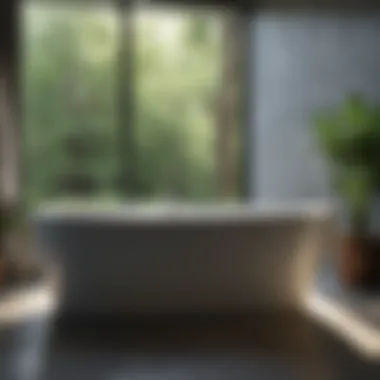

Preventive Measures Against Hard Water Stains
Hard water stains can be a significant and persistent issue for homeowners, particularly in areas with high mineral content in water. Understanding the importance of preventive measures against hard water stains is crucial in maintaining the aesthetic and functional integrity of your bathtub. By implementing strategies that curtail the formation of these stains, you can save time, effort, and resources in the long run.
Regular Maintenance Routines
Establishing a consistent maintenance routine is essential for preventing hard water stains from accumulating. This includes regular cleaning and inspection of your tub every week or bi-weekly. Here are some practices you might consider:
- Cleaning After Each Use: Quickly wipe down the surfaces with a dry cloth or a squeegee after each bath or shower. This simple act prevents water from evaporating and leaving mineral deposits behind.
- Use Gentle Cleaners: Opt for mild, non-abrasive cleaning solutions to avoid damaging the tub’s surface. Vinegar is an effective household cleaner that can break down mineral deposits.
- Inspect for Leaks: Periodically check your faucets and tub for leaks or drips. These can contribute to water pooling and lead to staining.
Engaging in these routines not only reduces the likelihood of stains but also enhances the longevity of your tub.
Water Softening Solutions
Consideration of water softening solutions can have a substantial impact on preventing hard water stains. Water softeners work by removing calcium and magnesium ions, the primary culprits in hard water. Here are the options:
- Ion Exchange Systems: These systems replace minerals with sodium ions, effectively softening the water. Installation may require professional assistance, but the long-term benefits include reduced staining and less frequent cleaning.
- Magnetic Water Softening: This solution uses magnetic fields to alter the properties of minerals in water. While results can be mixed, it is a more affordable option without significant installation costs.
- Chemical Additives: There are commercially available products that can be added to your water supply to inhibit mineral deposits. These can often be found at home improvement stores.
Each of these solutions requires careful consideration of your home's plumbing and personal preferences. The upfront investment can lead to less work and cleaner surfaces over time.
Choosing Tub Materials Wisely
The choice of materials for your bathtub is not merely aesthetic; it plays a critical role in how hard water affects your space. Some materials are more prone to staining than others.
- Porcelain Enamel: While attractive, this material can become scratched over time and can trap stains within those scratches, making them harder to clean.
- Acrylic: This synthetic material is generally resistant to staining, but it can discolor with prolonged exposure to harsh chemicals or very hard water.
- Fiberglass: An affordable option that is less resistant to scratching and staining. Regular maintenance is essential to prolong its life.
Assessing the materials utilized in your bathtub can provide not only aesthetic benefits but also functional advantages in preventing stains.
Regular maintenance combined with thoughtful choices in cleaning and materials creates a proactive approach to combating hard water stains.
Epilogue and Final Thoughts
Addressing hard water stains effectively is crucial for maintaining not just the beauty but also the longevity of your tub. Hard water stains, if not treated properly, can lead to a buildup that damages surfaces and becomes more difficult to remove over time. In this article, we explored various methods, from homemade solutions to specialized cleaning products. Understanding the best techniques allows you to choose the right approach depending on your situation.
Key benefits of tackling hard water stains include:
- Enhanced Aesthetic Appeal: A clean tub contributes to the overall appearance of your bathroom.
- Increased Longevity: Regular maintenance prevents surface damage and extends the life of your fixtures.
- Health Considerations: Removing stains can help eliminate bacteria and mold that thrive in damp environments.
Effective stain removal not only relies on the right techniques but also on the consistency of care put into your bathroom. Each method, whether using vinegar, baking soda, or specialized commercial products, has its unique advantages that cater to various preferences and needs.
Regular maintenance and timely intervention are essential to prevent stains from becoming a significantly larger issue. Creating a routine that includes cleaning practices and possibly investing in water softening solutions may further enhance the results you achieve.
"Investing time in caring for your space leads to better results and fosters a healthier environment."
Recap of Key Points
To summarize the important aspects covered:
- Understanding Hard Water Stains: Recognizing their causes and implications.
- Essential Tools and Materials: Identifying what’s necessary for effective cleaning.
- Homemade and Commercial Solutions: Weighing the options and their effectiveness.
- Step-by-Step Process: A systematic approach ensures thorough cleaning.
- Preventive Measures: Maintenance routines and better choices for tub materials.
Encouragement for Ongoing Care
Ongoing care is imperative for maintaining a clean tub. Establishing regular cleaning schedules can significantly reduce the impact of hard water stains. This might include simple daily practices like wiping down surfaces or using absorbent cloths after baths. Additionally, consider integrating water softeners into your home system to prevent new stains from forming altogether.
It is beneficial to embrace both routine and specialized cleaning efforts, depending on the severity of stains encountered. Remember, a clean tub not only looks good but it also adds to your overall bathing experience.
Taking these steps ensures that your bathing space remains an appealing sanctuary for relaxation and self-care.







